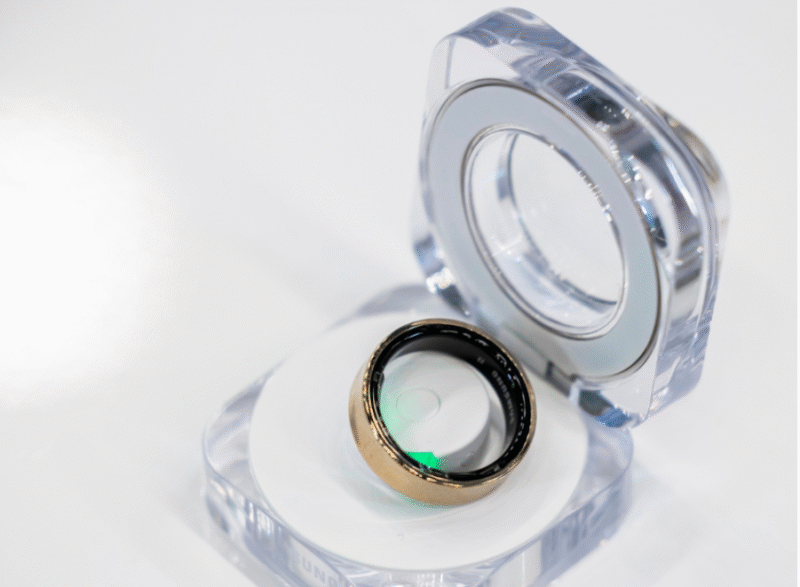Last updated on November 24th, 2025 at 05:42 am
I understand, I see, smartwatches are huge, look like they are shouting to the world that they are calculating your steps, and to be fair? They’re a pain to wear 24/7. This is the reason why I began to research smart rings.
It turns out that these mini gadgets cram some heavy technology into something that you can wear without the sensation that you are strapping a computer on your wrist.
Table of Contents
What Exactly Are Smart Rings?
Consider them fitness trackers the size of jewelry. Smart rings are rings that you can wear on a finger that will track your health measurements, activity, and even allow you to pay with a tap to get coffee. No display, no size – it is constant surveillance.
The following information is what struck me: they apply the closeness of your finger to blood vessels to get more precise heart rate readings than wrist-worn devices. This technology is referred to as photoplethysmography (PPG) and it sounds like a fancy word, yet it is simply the act of shining LED lights through your skin to gauge the flow of blood.
Within each of these rings is an amazing collection of gadgets: movement accelerometers, temperature sensors, oxygen sensors, Bluetooth, and a rechargeable battery that is less than a coin.
What Can They Actually Do?

Having conducted some research on the market (which is expected to reach 1.1 billion by 2030), I have discovered that smart rings perform very well at particular tasks:
They are most effective in sleep tracking. You are provided with a breakdown of light, deep and REM sleep phases with astonishing precision. As you are wearing them 24/7 anyway, you do not have to take off the smartwatch at night like you take off the smartwatch on the smartwatch.
Stress monitoring and heart rates occur continuously. They measure the variability of heart rate (HRV) so that they can see stress patterns in you before you have the conscious feeling of being overwhelmed. This was really helpful to me, your ring is practically warning you to pay attention to your body, heys, you are stressed, in case your brain hasn’t noticed yet.
The activity tracking is based on in-built accelerators. They record the number of steps and movement taken on a daily basis, but they are not so detailed as specific sports watches. Don’t look at GPS route mapping.
NFC technology contactless payments also allow you to pay with the tap of your ring. No wallet, no phone – no hand.
The Best Competitors (And at What Price)
This is where the interest comes in. I contrasted the most popular models, and there is nothing obvious about which one is the best:
The most complex tracker is Oura Ring 4 (priced at $349) that has 18-signal pathway sensors and best analytics. The catch? The subscription will be $5.99 a month. It is the iPhone of smart rings, sleek, strong, and you are stuck in their system.
Enterprise-level reliability is introduced to Samsung Galaxy Ring ($399). First generation product, but accuracy of sleep is dead on. This fits perfectly well should you already be in the Samsung ecosystem.
The most value I liked was RingConn Gen 2 ($299). You have 10-12 days of battery life (almost twice the industry average) and no subscription. Every feature is free. This is logical to those who are new to the waters.
Amazfit Helio (199) features titanium bodies and quick charge priced the least. No subscriptions, sleek style and will not cost the bank.
The Actual Limitations No One Speaks About.
The model has a battery life of 3-12 days. RingConn takes the lead of 10-12 days; the rest require charging everyday 5-7 days.
The size is important than you imagine. The rings must be bought with the correct size unlike smartwatches which have adjustable bands. Incorrect fits are painful or even slip off.
Privacy concerns are legit. These gadgets are tracking intimate health information day and night heart rate, stress levels, sleep patterns, history of locations. A great number of manufacturers distribute data with third parties without their express agreeableness. Select brands that have clear privacy policies.
This is important information: FDA specifically cautions that smart rings should not be used to measure blood glucose. Regardless of what certain companies would like people to believe, there is no FDA-approved non-invasive glucose ring. In case of diabetes, use approved monitors by FDA.
Should You Actually Get One?
Having researched the topic, I can say this: smart rings are better as sleep and activity trackers, but not as a substitute of workouts. In case you require a comprehensive fitness data with GPS, then sports watches are the way to go. However, when you need to monitor your health 24/7 but not be too big, they can really come in handy.
To new users, I would suggest RingConn Gen 2 or Gen Helio – both products are of great value, and they do not require subscriptions. Experiment with the idea and make decisions that are less expensive.
The smart ring market is expanding rapidly (21.1% per year), and such giants as Apple and Google are reported to do so in the nearest future. This is an indication of improved technology and reduced prices. But if you’re curious now? The available alternatives are already quite strong.
Just don’t expect miracles. They are not medical devices but health trackers, and this is the key to understanding that the point of difference is more than marketing would have you believe.
Also Read: Discord Roles Ideas: From Basic Setup to Community Gold
I’m a technology writer with a passion for AI and digital marketing. I create engaging and useful content that bridges the gap between complex technology concepts and digital technologies. My writing makes the process easy and curious. and encourage participation I continue to research innovation and technology. Let’s connect and talk technology! LinkedIn for more insights and collaboration opportunities:
